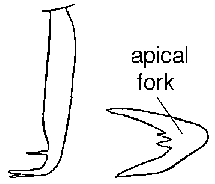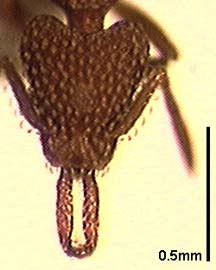Strumigenys louisianae Roger 1863
Dacetini, Myrmicinae, Formicidae, Hymenoptera, Insecta, Arthropoda, Animalia
John T. Longino, The Evergreen State College, Olympia WA 98505
USA.
longinoj@evergreen.edu
22 April 1997
|

Specimen: Costa Rica, Prov. Heredia: La Selva Biological Station (J. Longino 3196-s). INBIOCRI001237639. Image by J. Longino.

|

Specimen: Costa Rica, Prov. Heredia: La Selva Biological Station (J. Longino 3196-s). INBIOCRI001237639. Image by J. Longino.
line drawing of worker face, from Brown (1953). |
Identification
Apical fork of mandible with two tiny intercalary teeth; one conspicuous preapical tooth, but no other preapical denticles; outstanding setal pairs on sides of head and mesonotum spatulate, outstanding seta pair on humeral angles flagelliform, bent and coachwhip-like; gaster finely granular, opaque; erect setae on gaster strongly spatulate; posterior face of petiolar node rounded in posterior view. [The above applies to Costa Rican populations.]
Head length 0.46-0.64mm, mandible length 0.23-0.37, CI 77-92, MI 49-67 (n=130 workers from 71 localities; Brown 1962).
This is one of the most widespread and geographically variable species of the genus (Brown 1953, 1961). Material I have examined from Costa Rica is relatively uniform with respect to the above characters. Details of setal characters and gaster sculpture vary geographically.
Similar species: dubitata.
Range
Throughout tropical and subtropical America, from the southern United States to Argentina. In Costa Rica, known from Atlantic and Pacific lowlands, and the Meseta Central.
Natural History
Brown and Wilson (1959) summarize the genus as follows:
"Widespread in tropics and warm temperate areas. Primarily forest-dwelling; some species occur in grassland and arid scrub. ... Nests mostly in soil and rotting wood; a few species live in arboreal plant cavities in tropical rain forest. Foraging hypogaeic to epigaeic-arboreal. Food: most species are collembolan feeders; a few are polyphagous predators or occasionally feed on sugary substances..."
The feeding habits of louisianae have been studied by Wilson (1950, 1954) and Brown (1962). Workers take live prey, mostly small arthropods in litter and soil. Preferred prey are entomobryoid and symphypleonan Collembola; poduroid collembolans are not taken.
The species prefers synanthropic and/or seasonally dry habitats. It is more abundant in the peripheral parts of its range (Costa Rica northward, southern Brazil southward) than in the center (Panama southward to Amazonian Brazil) (Brown 1961).
Selected Records
La Pacifica: Winkler sample.
La Selva: two collections of foragers from the ground in young second growth vegetation.
Banana plantations of Palmar and Coto (reported in Brown 1961).
San Jose, Cartago, Colombiana and Hamburg farms in Limon province (reported in Brown 1953).
Literature Cited
Brown, W. L., Jr. 1953. Revisionary studies of the ant tribe Dacetini. American Midland Naturalist 50:1-137.
Brown, W. L., Jr. 1961. The neotropical species of the ant genus Strumigenys Fr. Smith: Miscellaneous concluding studies. Psyche 68:58-69.
Brown, W. L., Jr. 1962. The neotropical species of the ant genus Strumigenys Fr. Smith: Synopsis and keys to the species. Psyche 69:238-267.
Brown, W. L., Jr., Wilson, E. O. 1959. The evolution of the dacetine ants. Quarterly Review of Biology 34:278-294.
Wilson, E. O. 1950. Notes on the food habits of Strumigenys louisianae Roger (Hymenoptera: Formicidae). Bulletin of the Brooklyn Entomological Society 45: 85-86.
Wilson, E. O. 1954 ("1953"). The ecology of some North American dacetine ants. Annals of the Entomological Society of America 46:479-495.
 Go back to top
Go back to top


